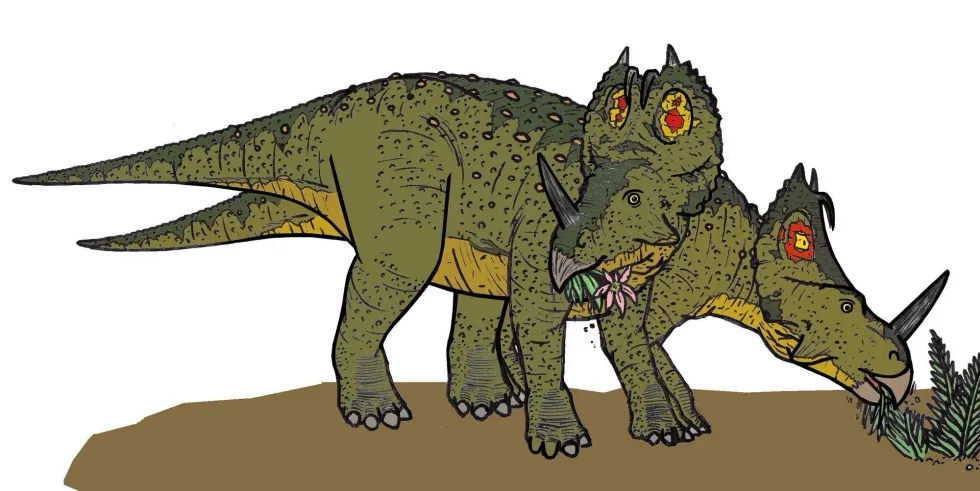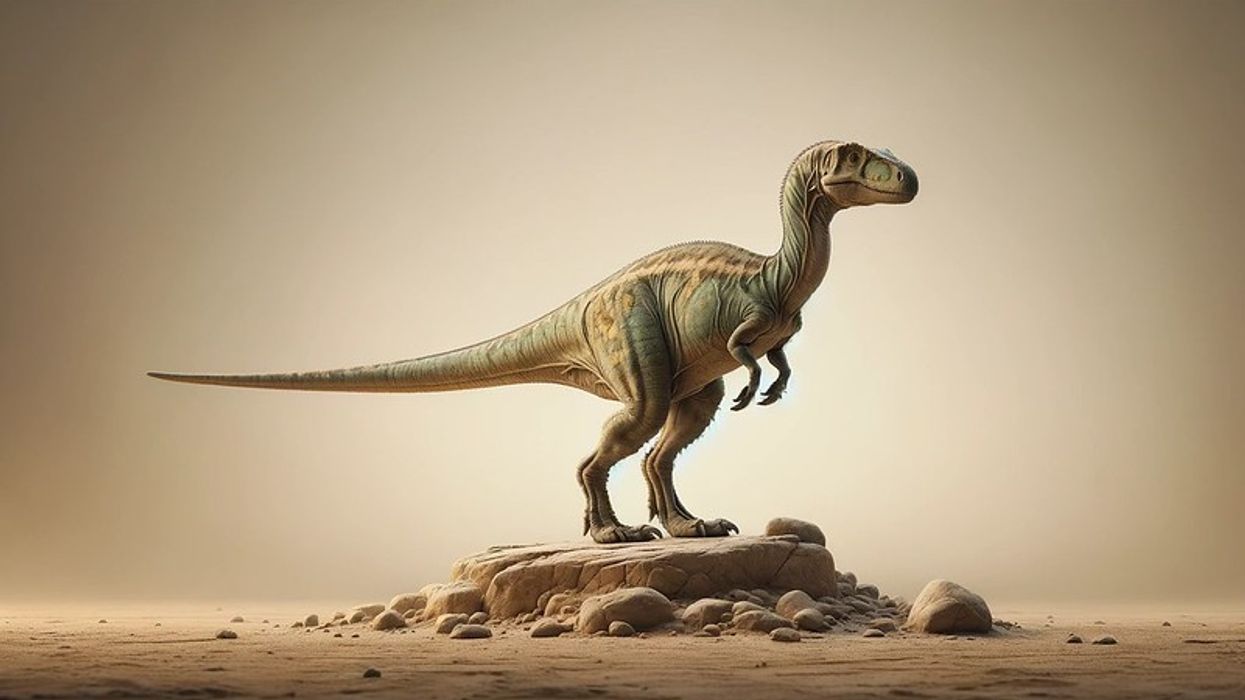The Monoclonius was found to have lived during the Late Cretaceous upper layers of the Judith River Formation in Montana, United States. The Monoclonius roamed the Earth during the Late Cretaceous period around 75 million years ago.
The habitat of the Monoclonius crassus was primarily terrestrial in nature with a vast variety of tundra, taigas, temperate deciduous forests, tropical rainforests, grasslands, and deserts. The adult Monoclonius was a very large dinosaur with big characteristic features. It roamed the earth during the early ceratopsian period.
They had huge flat feet with small nails. This species had a huge skull that was very heavy and was often held very close to the ground.
Its skull was 6 ft (1.8 m) long, where the head was measured from beak to frill. It even had prominent strong horns. This species had a four-horned skull.
The head had a small frill on it with a single upward pointed nose horn and two smaller horns over the eyes. The diet of the Monoclonius dinosaurs was primarily a combination of leaves, seeds, plants, and twigs.
For more relatable content, check out these Austroraptor facts and Incisivosaurus facts for kids.
Monoclonius Interesting Facts
How do you pronounce 'Monoclonius'?
The Monoclonius pronunciation is 'Mon-oh-clo-nee-us' which means single sprout, even though their horns are often mistaken for a single nasal horn, and it belongs to the genus Ceratopsian. This is often confused with the genus of Centrosaurus due to the similarities between them.
What type of dinosaur was a Monoclonius?
The Monoclonius was a herbivorous ceratopsian dinosaur. This dinosaur was found in the Judith River Formation in Montana, United States.
In which geological period did Monoclonius roam the earth?
The Monoclonius roamed the Earth during the Late Cretaceous period around 75 million years ago. They roamed the regions around the Judith River Formation in Montana, United States, and the uppermost rock layers of the Dinosaur Park Formation in Alberta, Canada.
When did the Monoclonius become extinct?
The Monoclonius became extinct around 75 million years ago with other dinosaurs of the genus of Ceratopsian.
Some interesting history about this dinosaur is that when the famous Cope had first named Monoclonius he was unsure how to arrange the name together, resulting in the incorrect identification of it being a hadrosaur dinosaur. Then, armed with the knowledge about Triceratops, Cope reassembled his Monoclonius fossils, identifying the horn core, neck frill, and cervical vertebrae, which he originally thought were the back vertebrae. This resulted in a re-description, published later, which saw the Monoclonius reconstructed as a ceratopsian dinosaur with a single large horn rising up from its nasal horn. However, Cope achieved this after adding additional fossil specimens to his existing Monoclonius fossils.
Where did Monoclonius live?
The Monoclonius Crassus lived in regions around the Judith River Formation in Montana, United States, and the uppermost rock layers of the Dinosaur Park Formation in Alberta, Canada near North America.
What was the Monoclonius' habitat?
The habitat of the Monoclonius crassus was primarily terrestrial in nature with a vast variety of tundra, taigas, temperate deciduous forests, tropical rainforests, grasslands, and deserts. They inhabited regions of Judith River Formation in Montana, United States, and the uppermost rock layers of the Dinosaur Park Formation in Alberta, Canada near North America.
Their diet included a number of plants and seeds.
Who did Monoclonius live with?
The social life of the Monoclonius dinosaurs is not known. However, their gigantic fossils and complete skeleton were found amongst fossils of a similar kind of dinosaurs so it is safe to assume that they probably lived in a group of three or four similar species of dinosaurs that have been listed under the family of Ceratopsians.
How long did a Monoclonius live?
The Monoclonius lived on Earth during the Late Cretaceous period between 75 and 74.6 million years ago. They lived for a fairly long period of time before natural disasters wiped out this group.
How did they reproduce?
The exact reproduction process of the Monoclonius is not known to us. But this dinosaur was an egg-laying species. They laid an average of two to three eggs. As suggested by the fossils of these dinosaurs, it is also assumed that the dinosaurs reproduced in a similar manner to modern-day reptiles.
Monoclonius Fun Facts
What did Monoclonius look like?

The Monoclonius was a very large dinosaur with big characteristics features. It roamed the earth during the early ceratopsian.
They had huge flat feet with small nails. This species had a huge skull. This skull was very heavy and was often held very close to the ground.
Its skull was 6 ft (1.8 m) long in which the head was measured from beak to frill. It even had prominent strong horns.
This species had a four-horned skull. The head had a small frill on it a single upward pointed nose horn and two smaller horns over the eyes.
This species had a short snout that ended in a parrot-like, toothless beak and this can be evidently spotted in these fossils but the Monoclonius also had many cheek teeth. This species walked on four feet with hoofed toes. It had a huge bulky body, and a short, thick, pointed tail identifying the horn core.
The cervical vertebrae were quite large and stiff which was originally thought of as the dorsal vertebrae as per paleontology. On the other hand, the Monoclonius juveniles of this species were only half the size of the adults with distinct eyes, pointed horns, and a small frill.
How many bones did a Monoclonius have?
The exact number of bones in the body of the Monoclonius species is not yet known to the Journal of Paleontology as the complete set of these specimens' fossils was never fully discovered. However, a prominent part of the fossils of this dinosaur's body was the skull bone, the head, and the teeth.
This specimen is popular for its hard, strong, and protective upper half.
How did they communicate?
The Monoclonius dinosaurs may have used loud voices and visual forms of communication. As per paleogeographic implications, the exact model of communication that took place between the dinosaurs is not yet known to man and paleontologists are yet to learn and access material that could give them a fair idea about this history.
But it is assumed that these dinosaurs might have used their voices and body language.
How big was the Monoclonius?
The Monoclonius dinosaurs were one of the largest dinosaurs in the history of these animals. This ceratopsian dinosaur was 16.4 ft (5 m) long and nearly twice the size of an Asaskacephale specimen.
How fast could a Monoclonius move?
According to history, most large dinosaurs were slow movers. Similar to other members of the Ceratopsian family, the Monoclonius were known to be slow movers.
The primary reason for their slow and easy locomotion was the shape and weight of the body and also the shape of their feet. Their speed would often make them fall prey to large predatory animals.
How much did a Monoclonius weigh?
The Monoclonius weighed 2,204.6-6,613.9 lb (1,000-3,000 kg). It was one of the heaviest animals in the history of dinosaurs. Most of its weight is a result of its upper body and bone weight as suggested by its remains.
What were the male and female names of the species?
No gender-specific names were assigned to any dinosaur's genera.
What would you call a baby Monoclonius?
The Monoclonius are hatched from eggs, therefore new baby dinosaurs can be called hatchlings, just like other reptiles such as turtles and crocodiles.
What did they eat?
The diet of the Monoclonius was primarily a combination of leaves, seeds, plants, and twigs. These animals had sharp teeth and did not need to eat stones in order to grind the food in the stomach. This animal was a herbivore similar to all other Ceratopsians who are herbivorous too.
How aggressive were they?
Monoclonius dinosaurs were non-aggressive animals and can be described as gentle giants, unlike other members of the cretaceous family. These animals used their nose and visual abilities to predict danger. In fact, Monoclonius would hide away instead of showing aggression and anger around their predators. These dinosaurs were herbivorous and did not harm any other species of dinosaurs.
Did you know...
Initially, there was a lot of confusion about the meaning and classification of the name Monoclonius with many people interpreting it as meaning ‘single nasal horn’ when in fact it still meant ‘single sprout’, a reference to their teeth.
The Monoclonius was initially named Monoclonius sphenocerus and only after further classification and discovery was this animal renamed and noted as the Monoclonius crassus.
A number of articles have been written by the Indiana University Press about dinosaurs but the article about the Monoclonius is the most famous one as it records the entire series of the evolution of the characteristics of this horned herbivore genera.
Several fossils were found and the classification was done by Cape but assisted and assigned by Charles Hazelius Sternberg into this genera.
Why are they called Monoclonius?
The name of the Monoclonius Crassus means single sprout, from Greek monos, 'single', and klonion, 'sprout', in reference to the way its teeth grew compared to its relative 'double sprout', which was named by Edward Drinker Cope in the same paper as Monoclonius. The name was inspired by its features that were a discovery from its remains.
These features included a horned face, their teeth, and their frill bone.
How many specimens of Monoclonius were discovered?
Multiple species were discovered. The dubium species included M. crassus Cope, M. sphenocerus , M. fissus, M. lowei, and a few more.
The former species included M. belli Lambe, M. cutleri Brown, M. nasicornus, M. montanensis, and many more.
Here at Kidadl, we have carefully created lots of interesting family-friendly dinosaur facts for everyone to discover! Learn more about some other dinosaurs from our Einiosaurus fun facts and Micropachycephalosaurus fun facts for kids pages.
You can even occupy yourself at home by coloring in one of our free printable Monoclonius coloring pages.









